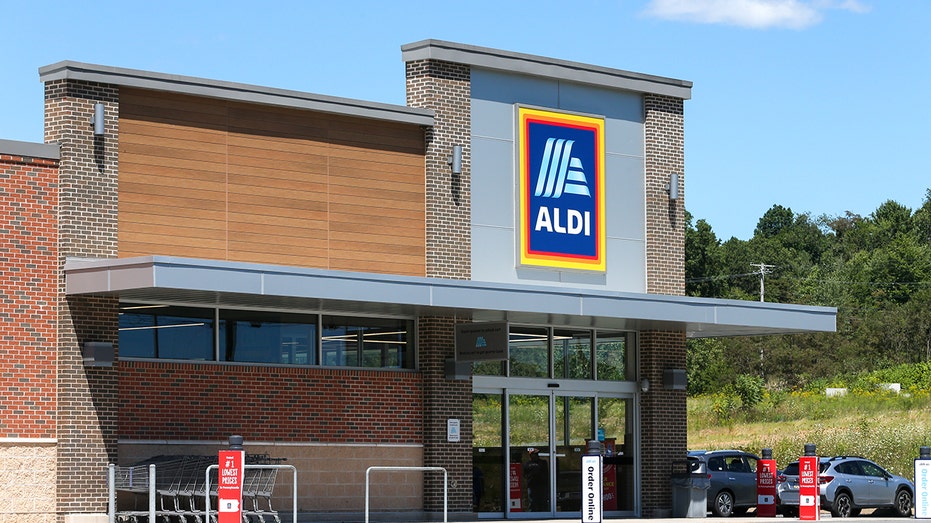Discount grocer Aldi is boosting its staff for the holiday season with plans to hire more than 13,000 store and warehouse workers.
Along with boosting its workforce, the grocer announced that it will continue adding new stores across the U.S. while it simultaneously prepares for the busy shopping period.
To entice applicants, the company also announced that it's raising the national average hourly pay too.
The average starting wages for Aldi store and warehouse positions nationwide will jump to $18 and $23 per hour, respectively, based on market and position, according to the company.

The average starting wages for Aldi store and warehouse positions nationwide will jump to $18 and $23 per hour, respectively, based on market and position, according to the company. (Burak Bir/Anadolu Agency via Getty Images / Getty Images)
The company also touted that the company "outranks competitors" in career opportunities, noting that 70% of assistant store managers and more than 30% of store managers started as store associates.
Workers with more than 30 hours a week have access to health insurance, paid time off as well as flexible scheduling, and 100% paid parental and caregiver leave, Aldi said.

Aldi announced it is raising the national average hourly pay. (Paul Weaver/SOPA Images/LightRocket via Getty Images / Getty Images)
Any qualified applicants will be invited to interview during National Hiring Week, which ends on Sept. 15.
This is just the beginning of the holiday hiring rush. Typically, as the season gets underway, grocers, retailers, and companies like UPS and FedEx boost their seasonal workforce to handle the rush of holiday shoppers.
NRF CEO Matthew Shay expects consumers to keep spending as we head into the holiday season despite the slowing labor market.
Even with lower "employment growth, unemployment is near historical lows and ongoing job and wage gains coupled with lower inflation should keep consumers on solid footing heading into the holiday season," Shay said in August, adding that "lower interest rates take time to trickle down and won’t provide an immediate boost but should stabilize the economy."
Job-hunting in the current labor market can be a daunting prospect, especially as other candidates pursue the same openings.
Competition has ramped up this year as LinkedIn job listings in all 50 states have seen increases in the number of candidates seeking consideration for roles, Resume.io reported in a new study.
The study determined the states where job seekers face the most competition with their applications and provided other findings such as those on global job markets. The resume-focused platform analyzed some 40,000 LinkedIn listings in America for its U.S. rankings and over 104,000 total.
Washington ranked No. 1 out of the 50 states for "most competitive U.S. job market" because positions in the Evergreen State attracted 41 applicants on average within seven days, per the study.
Seattle's experiencing surging competition contributed to Washington taking the top spot, Resume.io reported. Jobs there were notching an average of 40.9 resumes in their first week, marking a 445.4% jump from 2023 and earning it the global top spot, the study said.

Seattle's surging job competition contributed to Washington state taking the top spot in the study, Resume.io reported. (George Rose/Getty Images)
In second place was Colorado. Job postings in that state averaged 28.11 applicants in their first week of being live on LinkedIn, according to the study.

A view of Boulder, Colo. (George Rose/Getty Images)
Massachusetts, the state that Resume.io dubbed the third-most competitive, was not far behind at 27.81.

Boston's skyline (Ron Dahlquist/Design Pics Editorial/Universal Images Group via Getty Images)
Two other Northeastern states – New York and its neighbor, New Jersey – also made the top five for job competition. In the Empire States, an average of 25.49 people applied for each job in the first week. New Jersey’s average was 25.37.
CLICK HERE TO READ MORE ON FOX BUSINESS
Competition growth rates for the five top states also varied quite a bit, with Washington’s jumping 419% from 2023 and Colorado’s rising 70.4%, for example.

The "coffee cup test" is a job interview evaluation used by hiring managers to see if candidates will offer to clean up after themselves. (iStock)
Meanwhile, the five states found to host the least competitive job markets included Wyoming, Alaska, South Dakota, North Dakota, and Montana. Job postings in those states tended to field an average between 3.64 to 4.5 candidates in the first week, Resume.io’s survey found.
Separate data from Workday suggested job hunters will face the most competition from other candidates for roles within communications, media and technology, financial services, and certain other industries.
Across the U.S., the unemployment rate hovered at 4.2% in August, according to the federal government. The labor force participation rate was 62.7%.

